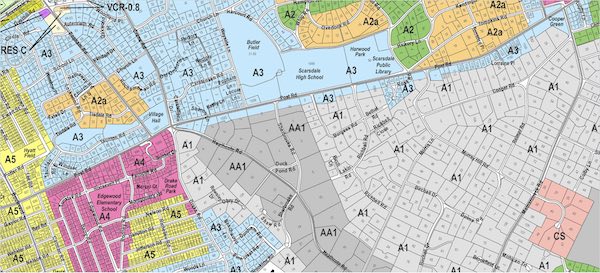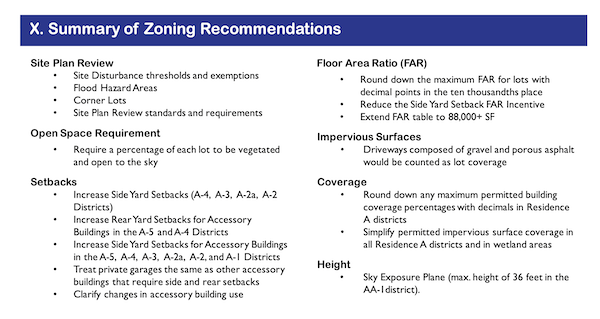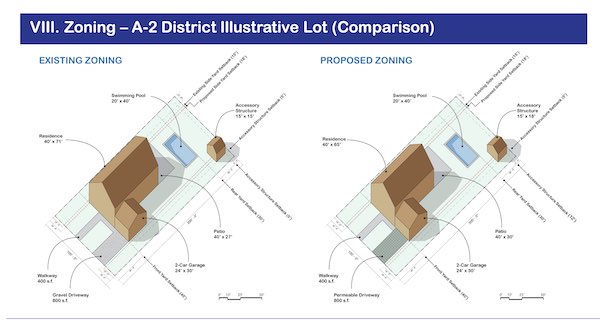Zoning Code Changes: Too Little For Some, Too Much For Others
- Wednesday, 29 May 2024 17:14
- Last Updated: Wednesday, 29 May 2024 22:26
- Published: Wednesday, 29 May 2024 17:14
- Joanne Wallenstein
- Hits: 4402
 Mayor Justin Arest said it all at the close of the public hearing on May 28 about proposed building code changes in Scarsdale when he said, “More than half think it doesn’t go far enough and another think it goes too far.”
Mayor Justin Arest said it all at the close of the public hearing on May 28 about proposed building code changes in Scarsdale when he said, “More than half think it doesn’t go far enough and another think it goes too far.”
He was referring to a long list of revisions to Scarsdale’s building code, recommended by Planning Consultants BFJ. The recommendations were first presented to the public at a meeting on Tuesday May 14.
On May 28 consultants presented their recommendations again, and the public had the opportunity to comment.
In brief, the consultants propose to use the following tools to reduce lot coverage, increase open space and improve stormwater absorption. Each alone would not have a great impact, but consultants say the combination of these factors together should have a meaningful result.
Here are the changes they are suggesting:
-Planning Board Review for site disturbances at defined thresholds by lot size, for building in flood hazard areas and on corner lots.
-Open space percentage requirements by zoning district.
-Slight increases in side yard setbacks for some zoning districts excluding the smallest and largest lots.
-The addition of side and rear yard setbacks for accessory buildings (like garages).
-New maximum floor area ratio (FAR) requirements as defined.
-Change in the definition of “impervious” surfaces to include gravel and asphalt, thereby reducing the amount of impervious space on a lot.
-Sky exposure plane for lots two acres or greater which would permit the maximum height to go from 32 to 36 feet provided that the front of the house is setback a minimum of 75 feet.

The consultants have received comments from the Zoning Board of Appeals and the Planning Board and those changes will be incorporated into future drafts of the proposal.
This initial proposal addressed house bulk and lot coverage, leaving aside issues of tree removals and subdivisions. So for some it did not go far enough to protect Scarsdale’s tree canopy which has seen tremendous losses in recent years. Others feared the new requirements would prevent them from adding on to existing homes and they were not clear on how they would be impacted.
Here are excerpts from some who commented:
Jordan Copeland said, “Sky exposure plane is important. Why not include this provision for other houses as well. My wish is that you can’t build a house with more than 110% of the sky exposure plane of all the other houses on the street. Taller structures right up to the setback are a concern. Expand the sky exposure plane to all neighborhoods.
Paul Diamond, a builder, asked for a clarification of “the definition of disturbance so you don’t necessarily have to go to the Planning Board” for review. He also said the new setbacks would result in non-conforming lots.
Anne Hintermeister said, “This is the board’s answer to bulk and stormwater. I think it’s an insufficient answer to either of these. I think the Planning Board agrees. Fish says “he hopes it will have an impact.” These are modest changes to existing laws. They don’t address subdivisions and replacing 2 homes with one. I don’t think we should pass a law based on what you hope. What will be the changes to runoff – how would this impact situations like Chase and Church Lane? The tree canopy is a huge issue – it is a community asset that makes us special. I don’t think we should allow the diminution of the tree canopy. Preservation of the tree canopy should be mandated. Please read the Forum report.”
Deborah Russel said, “I am disappointed that there is no acknowledgement of the cost of flooding to residents that results in street closures and downed power lines. There is no acknowledgement that its taxpayers who are paying the costs. I don’t hear anyone connecting the dots. I don’t hear them saying that what they are proposing will reduce the problem. Why are we using Mamaroneck as an example? Look hard at the cost of these problems – and show how these proposals are designed for the benefit of Scarsdale’s taxpayers.”
 A comparison of a building plan under the new and the old code.
A comparison of a building plan under the new and the old code.
Jim Detmer said, “On the surface these proposals make sense. But it is difficult to envision how these measures would impact stormwater runoff. A minimal decrease? Is there any way to model an overbuilt lot against what would have been there (under the old laws.) Why do we need building bonuses and far incentives? We must control bulk appearance. We will inadvertently create a townhouse effect with 32 foot houses only 10 feet apart. This is leaderships opportunity to do this – let’s be bold.”
Joan Weissman said, “The proposed amendments are a step in the right direction, but they must be strengthened to have any real impact. The open space requirement is a welcome addition, but a more comprehensive explanation as to how this proposal relates to setbacks and lot coverage is necessary. In any event, in order to truly increase green space, all setbacks and the open space requirement should be increased beyond what is recommended.
The inclusion of porous asphalt and gravel in the definition of impervious surface is long overdue. But, the use of permeable pavers as a substitute is not the answer. Permeable pavers over time lose all or most of their ability to allow water to soak through unless proper maintenance is conducted so that the voids in the joints do not become clogged. This issue is raised in the NYS DEC Stormwater Management Design Manual as well as by NYC and the US Dept of Energy and Environment. There is no feasible way for the village to assure that the requisite maintenance, which may be required several times a year, is carried out. The use of permeable pavers will have the same negative consequences that are experienced with the use of gravel and porous asphalt.
The proposed requirement that the issuance of a certificate of occupancy be based on the Village Building Inspector and Engineer’s review and approval of the As of Built Survey does not address the problem it seeks to solve. By the time construction is completed, it is too late to discover that plans have not been followed. It is imperative that village staff be mandated to review measurements and calculations contained in submitted plans prior to any permit approvals and to carry out inspections throughout the construction process to confirm that approved plans are being followed.
The legislative intent and purpose of the law establishing the moratorium states that among the adverse impacts of development in Scarsdale are the “negative environmental impacts such as the destruction of mature trees and natural habitats.” We all know the crucial role trees play in providing a healthy environment. The recommended code changes do nothing to preserve our village’s trees or natural habitats. The proposed amendment that simply requires certain site plans include a description of the location of different areas of vegetation and of certain trees provides no protection for any vegetation, including trees. I urge the Board to address Scarsdale’s ongoing canopy loss as well as the loss of our natural habitats by making the necessary changes throughout the village code.”
Madelaine Eppenstein discussed the “ongoing exploitation of the Village tree canopy.” She said, “Responsible development should protect the Village tree canopy and not help to destroy it. Trees mitigate stormwater runoff. The last time the tree code was updated was 2018-19 and there were many compromises made. I suggest we go back to this code and protect our environment.”
Linda Killian said, “Most of our community was developed in the early part of the century as a railroad suburb. Our neighborhoods were put together with a lot of thought to setbacks and style – no two were alike. People are objecting to the new cookie cutter houses, that are too large. Would these proposed changes prevent subdivisions like that? On 27 Woods Lane, would these new rules prevent two out of whack, out of context houses from being built there?
Cal Petrescu who is an architect and resident said, “Wider driveways would affect the open space provisions.” Referring to the decrease in the setback bonuses he said, “Without the bonus, developers may increase the width to increase curb appeal. Buyers count on these bonuses. Losing a small bedroom is drastic. Reducing setbacks makes lots non-conforming. Houses will be non-conforming and less likely to sell.”
Barry Abramson said, “These revisions are only a small first step and don’t address the issues of our stormwater infrastructure. I don’t see how this will address our flooding. Even if every new house is in compliance, they will still be larger than the old house it replaces. No one goes smaller in Scarsdale.”
Cathy Liu who is a stormwater engineer said, “The Village has changed the code about gravel several times. I hope in the future we don’t need consultants to tell us that gravel should be considered as impervious. I am also concerned with pervious pavers. They have to be maintained.”
Elaine Weir said, “I am concerned about flooding. The land use proposal does not address this. It does not increase our flood plain which is obsolete. We need a realistic flood map and then we need to increase it to account for climate change. We need to prohibit subdivisions in flood prone areas. It poses risks to the surrounding homes. This causes neighbors costly clean ups – especially when the new house is on landfill. Spacious neighborhoods keep property values up for everyone. We need to prepare Scarsdale for the future by not overbuilding. The current proposal needs to be stronger.”
Claudine Gecel who lives on Kent Road said that a house on her street is flooding. She said, “It’s next to a subdivision and the land for the next house was clear cut.” She said referred to homes built on Fox Meadow Road and Paddington Road using cultecs to store the water. And said “they did not hold the water and a month ago the road needed to be shut down due to flooding.”
Addressing Gecel, builder Eilon Amidor said, “We have a plan to resolve the flooding.” He said, “Every decision limiting development will hurt the Village. We have to make a referendum because it’s a big decision for a lot of people with a lot of money. I am sure the people would vote no. I build in Mamaroneck They need to resolve their flooding issues. I would not use any examples from Mamaroneck. We will have a catastrophic jam at the Planning Board. You’re making problems for designers. You’re making smaller houses. I did a three-lot subdivision – people told me it will look like Queens.”
Sean Danahey said, “Everyone is speaking about changes in our designs. There are unintended consequences. Not being able to expand the house could have serious economic consequences.”
Tom Shorter said, “A lot of homes are being torn down changing village character.” He asked the board to “Protect the ability of homeowners to make changes or else these homes will be ripe picking for the contractors. I don’t see the young residents here. They will find out in a year when they want to expand and find these changes can’t be done.”
Joe Zakierski said, “The proposal is long, difficult to digest and to understand. Many are unaware this is happening. Information is harder to come by. I am concerned that the trustees have the power to sign off on this without wider community input. It is imperative to get more people educated. I like the idea of a town wide vote. Perhaps we should have separate regulations for existing homes and new builds. To make these changes you need to be sure.”
Emilie Cordell asked the consultants to visit some of the properties that are of concern.
She discussed “extraordinary noise caused by rock blasting. Saying “There is no parameters around this.” She said, “Take a look at a street. I live in Edgewood – they are maxing out the lots.”
Mayor Arest replied to Cordell saying that a noise ordinance had recently passed that regulates noise from construction.
Michelle Sterling said, “Permeable pavers are a misnomer. They are impermeable but there are gaps between them. They have to be properly installed. The gaps need to be kept clear of silt and over time those gaps fill up. It takes extensive maintenance. Pavers retain and emit heat while grass cools. Permeable pavers are not permeable.”
Miriam Petrescu said, “Look at all the homes that will become non-conforming. You need to advise the residents.”
Jon Spivak called in and said, “I have barely skimmed this document. I don’t know if this is good or bad. We have to know what this means for us and our homes.”
In comments from the trustees, Dara Gruenberg replied to Joe Zakierski. She said, “I want to address the “lack of transparency.” She said, “We created Scarsdale Official. There is also personal responsibility You need to educate yourself and spend the time. Maybe we can make it more digestible. These are complicated issues that takes time to digest.”
Karen Brew said, “We need to make enough of a difference -and I question whether these go far enough.” She asked the Village Planner to take a look back at houses that have been built and how this would affect those plans.
Ken Mazer asked for an analysis of a random sampling of past BAR applications for home additions and what the new regulations do to these applications.
Jeremy Wise said, “It is complicated. My head is spinning. I would like to see a summary…. one document that is an official document of the board.”
A second work session is planned for June 11 with a vote on the new code on Tuesday June 25, 2024.
See the proposed code and the presentation here.







